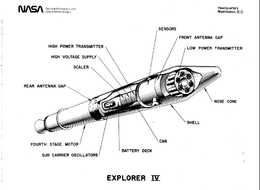Explorer 4

Explorer 4
|
|
| Mission type | Earth science |
|---|---|
| Operator | Army Ballistic Missile Agency |
| Harvard designation | 1958 Epsilon 1 |
| SATCAT № | 9 |
| Mission duration | 71 days |
| Spacecraft properties | |
| Manufacturer | Jet Propulsion Laboratory |
| Launch mass | 25.50 kilograms (56.2 lb) |
| Start of mission | |
| Launch date | July 26, 1958, 15:00:57 UTC |
| Rocket | Juno I |
| Launch site | Cape Canaveral LC-5 |
| End of mission | |
| Last contact | October 5, 1958 |
| Decay date | October 23, 1959 |
| Orbital parameters | |
| Reference system | Geocentric |
| Regime | Medium Earth |
| Semi-major axis | 7,616.2 kilometers (4,732.5 mi) |
| Eccentricity | 0.1279360055923462 |
| Perigee | 263 kilometers (163 mi) |
| Apogee | 2,213 kilometers (1,375 mi) |
| Inclination | 50.29999923706055 degrees |
| Period | 110.20 minutes |
| RAAN | 82.42 degrees |
| Argument of perigee | 57.72 degrees |
| Mean anomaly | 303.52 degrees |
| Mean motion | 15.52 |
| Epoch | 2 October 1959, 06:53:14 UTC |
| Revolution number | 6070 |
Explorer 4 was an American satellite launched on July 26, 1958. It was instrumented by Dr. James van Allen's group. The Department of Defense's Advanced Research Projects Agency had initially planned two satellites for the purposes of studying the Van Allen radiation belts and the effects of nuclear explosions upon these belts (and the Earth's magnetosphere in general), however Explorer 4 was the only such satellite launched as the other, Explorer 5, suffered launch failure.
Explorer 4 was a cylindrically shaped satellite instrumented to make the first detailed measurements of charged particles (protons and electrons) trapped in the terrestrial radiation belts.
Launched from a Juno I rocket, the mission remained secret from the public for six months.
The satellite telemetry was analyzed for three Operation Argus nuclear weapons tests at high altitude.
An unexpected tumble motion of the satellite made the interpretation of the detector data very difficult. The low-power transmitter and the plastic scintillator detector failed September 3, 1958. The two Geiger-Müller tubes and the caesium iodide crystal detectors continued to operate normally until September 19, 1958. The high-power transmitter ceased sending signals on October 5, 1958. It is believed that exhaustion of the power batteries caused these failures. The spacecraft decayed from orbit after 454 days on October 23, 1959.
...
Wikipedia
